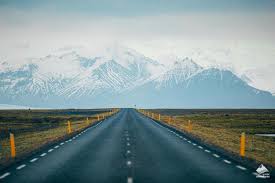Iceland Driving Advice and Car Hire Info



Driving In Iceland
Iceland drives on the right and you can use the photo licence of any country to drive here, providing the licence is written in the Roman alphabet .Drivers from other countries need their own licence plus an international driving permit. Speed limits are low in Iceland -ranging from 90kmh on motorways to 90kmh on paved rural roads roads, 80kmh on gravel rural roads and 50kmh in urban areas.
Roads in Iceland are broken into the following classifications –
Primary roads connect the country’s urban areas. There are 4425km of primary roads in the country. The most famous primary road is the Ring Road, which goes around the whole island and through the main cities of Reykjavik and Keflavik. Primary roads are well maintained and are usually open all year.
Primary highland roads -Highland roads are usually narrow gravel roads or tracks and most rivers are unbridged. 505km in the country. Primary highland roads are often called F-roads and are prefixed with an F in front of the road number. This type of road is usually closed in bad weather, sometimes remaining closed throughout the winter. They’re usually gravel so a 4×4 is recommended. Tell the rental company if you intend to drive on a Highland road so they can recommend an appropriate vehicle.
Secondary roads are roads outside populated areas that connect primary roads or highland roads to a primary road. 2956km in the country which are generally around the coast. They usually remain open in bad weather, but are usually gravel, so a 4×4 is better than a normal car if you’ll be using them regularly.
Local access roads are roads to farms, factories, churches, public schools and other public places located outside populated areas. 3091km in the country and usually maintained by the owners of the buildings that they link to the main road so will be in varying condition.
Highland roads – Non primary routes across mountains and moors. These roads are usually with seasonal traffic and limited services. Highland roads are usually narrow gravel roads or tracks and most rivers are unbridged. 1921km in the country.Also called F Rods and generally gravel. They will often be impassable in winter and a 4×4 is recommended all year.
Less than one-third of Iceland’s total road network is paved. Route 1 or the Ring Road, Þjóðvegur 1 or Hringvegur in Icelandic, is the main paved route around Iceland and runs for 1,322 kilometres connecting Reykjavík with other urban areas, and providing access to most of the tourist attractions in the country, such as the Seljalandsfoss and Skógafoss waterfalls, Dyrhólaey and the Jökulsárlón glacier lagoon. the road is in generally good condition but isn’t a multi-lane highway.
When driving in the highlands you may need to cross small rivers via fords, and its not always easy to judge the depth of the water. If theres no one around to ask, and no other vehicles crossing you may need to resort to wading in and testing the depth- chilly but better than getting stuck! The F208 and F225 to Landmannalaugar are two highland roads which are only open for a few months a year to 4WD vehicles and you should always check conditions before setting off to drive them as they entail a number of river crossings. They usually don’t open until mid June and close again in September. This website has useful info on likely opening dates for mountain roads.
Driving in Iceland is generally stress free. The driving standards are high and drivers are considerate, even in the centre of Reykjavik, which feels like driving in a small town compared to most European Capital Cities.
One quirk of driving in Iceland to consider is that at the height of winter it only gets light at mid day for a couple of hours. Its a strange feeling to collect your hire car at 9am and drive for 3 hours before it gets light! One effect of the long hours of darkness in my experience is that you tend to feel more tired than you normally would, so you should take this into account when planning your trip. The flipside obviously is that in Summer you get long days which enable you to see more sights in a limited time frame.
Iceland is a bigger country than many people think and with low speed limits, journeys can take longer than you expect. Some driving distances and approximate travel times to popular attractions and major settlements are as follows-
Reykjavik to Akureyi , 389 km, 5 hours
Reykjavik to Borganes , 74km, 1 hour
Reykjavik to Isafjordur, 457km,8 hrs 30
Reykjavik to Seydisfjordur 680km, 9hrs 30
Reyjavik to Geysir ,120km, 2 hours
Reykjavik to Skaftafell National Park 340km, 5 hours
Reykjavik to Grindavik (Blue Lagoon) -40km, 30 mins
Reykjavik to Snæfellsnes ,120km , 2 hours
Although I try and keep the information in the site updated as much as possible, in a rapidly moving world, situations can change daily. Therefore please use the site as an approximate guide, and in conjunction with other resources in order to form your view on driving conditions, roads, safety etc.
Iceland Car Rental –
Sixt, Hertz, Europcar, National, Alamo,Avis, Budget, Thrifty, Dollar, have outlets here. Also usually features on Car rental broker sites and Web discount sites such as rExpedia
We currently have no local car rental partners in Iceland. If you are a local car rental company who would like to feature on DriverAbroad.com please check details on our Partnering page or contact us on ADriverAbroad@Outlook.com
Iceland Self Driving Rules –
Vehicles can’t be taken off Iceland. One way rentals should be possible with the larger firms although as the only main airport is in Reykjavik its likely you’ll want to return there anyway.

1 comment